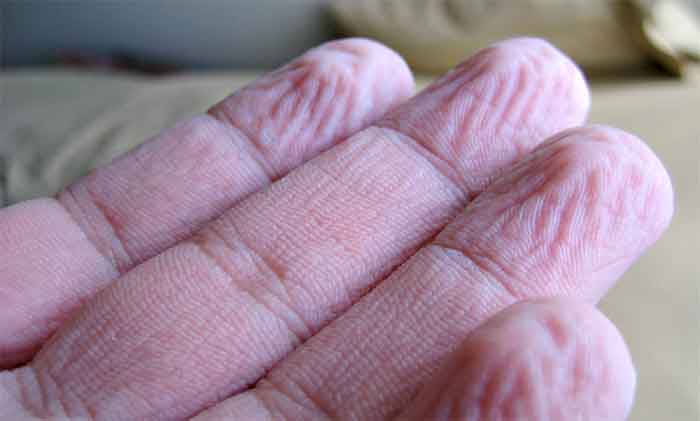
The pruning up of fingertips when we bathe or swim is a phenomenon of the human body that is so common and yet little understood. Despite many decades of scientific inquiry, until recently, the reasoning remained elusive. A common belief was that the wrinkling of wet skin was caused by osmosis. But a definitive study in 2011 turned the enigma of “wet-induced wrinkles” from a passive, purely chemical reaction of water molecules into an interesting evolutionary idea—what if pruney skin was an adaptation that gave our ancestors a better grip in wet conditions?
Let’s explore the experimental and historical reasoning that led to this understanding of what water does to fingers and toes.
The scientific reason why human skin develops wrinkles when it has been exposed to water is grounded in the anatomical structure of the skin. Skin is composed of three layers. The epidermis (the outermost layer) hydrates the body. The dermis (the middle layer) assists in thermoregulation. Finally, the hypodermis (the deepest layer) protects the body from harm. It is the epidermis that holds the key to understanding pruney skin. As Richard Gray reports in a June 2022 BBC article, citing the 2003-2004 work by neurologists Einar Wilder-Smith and Adeline Chow, the pattern of skin wrinkling in water “depends on the way the outermost layer of skin—the epidermis—is anchored to the layers beneath it.”
The common misconception that osmosis-related swelling is the sole reason our skin wrinkles in water hinges on the idea that as the epidermis encounters water, water molecules pass through the epidermis from the watery environment into the skin cells. This happens most noticeably in fingers and toes because the outermost part of the epidermis contains a layer of dead keratin cells that is thickest on the hands and feet. (The keratin layer serves to protect the nerves and tissue below the skin from being harmed with their use during our regular, skin-abrasive activities such as scrapes and grazing.) But as Becky Summers writes in a 2013 Nature magazine article, the osmosis theory has been criticized since the 1930s, when researchers discovered that skin wrinkling “does not occur when there is nerve damage in the fingers.” In light of the discovery of the nervous system’s role, another factor besides osmosis must contribute to the reasoning behind the activity of wrinkling—perhaps, another line of thinking went, constriction of blood vessels underneath the surface of the skin was the primary cause of the wet-skin wrinkling effect.
Some scientists have suggested wrinkling to be an evolutionary function and one that our body has adapted over time. A leader in 21st-century thinking on the question is Mark Changizi, an evolutionary neurobiologist at 2AI Labs in Boise, Idaho. He and his team worked to prove that the pattern of skin wrinkling appeared to be optimized for providing a drainage network that improves grip. One of the helpful analogies they invoke is that of rain treads on a tire: the wrinkle patterns on wet fingertips similarly help with draining water and increasing surface area for a better grip.
Changizi’s study upended the previously generally accepted belief about osmosis and built on the work of Wilder-Smith and Chow and others regarding the involvement of the nervous system and vasoconstriction in the phenomenon. In Changizi’s 2011 study published in the scientific journal Brain, Behavior, and Evolution, participants picked up wet or dry objects including marbles of different sizes. Half of them picked up the objects with dry, unwrinkled hands, and the other half picked up objects with wrinkled fingers that they had soaked in water for 30 minutes. The participants picked up the wet marbles faster with wrinkled fingers rather than the ones with dry fingers. Wrinkled fingers seemingly made no difference to the speed of picking up dry objects. In other words, the rain tread effect channels water away from fingertips and aids in the ability to grip wet objects.
Until Changizi’s study, there was no concrete proof that wrinkled fingers offered humans any advantage. Just five days after the study was published, science journalist Ed Yong covered the exciting new hypothesis and the reaction by Changizi’s colleagues in Nature. By proving the utility of pruney fingers (the evolutionary biological key beyond the underlying science of water and human biochemistry), the study transformed our understanding of the purpose of wrinkled fingers.
The study also raises questions about how the wrinkling adaptation helped our ancestors. Certainly, it made it easier for them to gather food from wet vegetation and provided better grip in the rain. Archaeological researcher Deborah Barsky details the extent to which the Homo genus had to adapt to more aquatic environments in her 2022 book, Human Prehistory: Exploring the Past to Understand the Future. She describes how the “distant past offers new perspectives on present-day challenges,” linking the idea that wrinkled fingers could be an archaic trait that we share with our even earlier ancestors.
The wrinkling of wet hands and feet certainly confers an advantage when it comes to gripping objects, and there appear to be no clear evolutionary disadvantages. There are clear implications that suggest this adaptation had advantages for our ancestors. Was this adaptation crucial to our survival? Was it needed for our ancestors to grip fruit in the rain and catch fish in marshes? To escape predators by climbing wet terrain? It is likely that the answer goes beyond one simple, definitive one. There may be yet other advantages lurking within the crevices of our wrinkled fingers and toes waiting to be discovered.
Omala Snyder studies English literature, creative writing, and international relations at Dartmouth College, where she works at the student newspaper. Born and raised in London, England, she plans to pursue a career in journalism.
This article was produced by the Independent Media Institute.











































